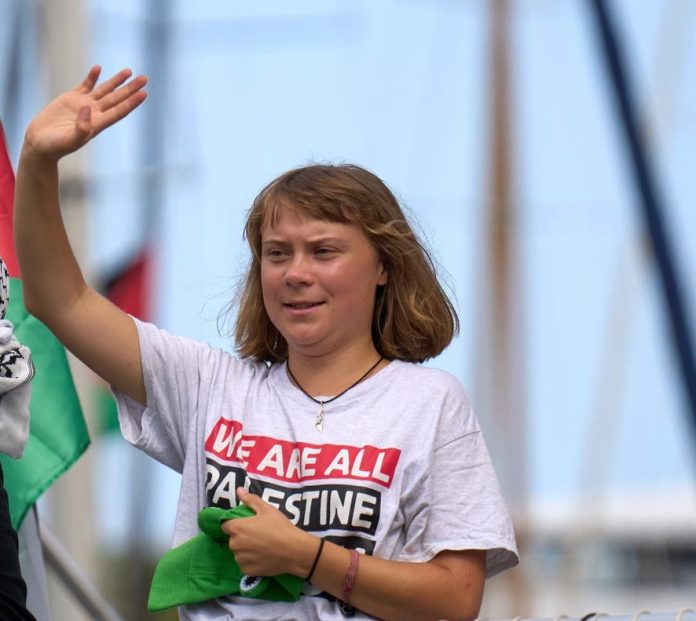– Mohammed Talha Siddi Bapa
Greta Thunberg was born on a quiet January day in 2003 in Stockholm, Sweden. At first glance, she was like any other child – curious, quiet, observant. But early on, her parents knew she saw the world differently. Diagnosed with Asperger’s syndrome, OCD, and selective mutism, Greta spoke little, but when she did, her words cut clean.
Her mother, Malena Ernman, was a famous opera singer who had once performed on the Eurovision stage. Her father, Svante Thunberg, an actor and producer, was the grandson of Nobel scientist Svante Arrhenius. A family of voices and visionaries. But it was Greta who would come to speak loudest.
She first heard about climate change in school at the age of eight. While her classmates quickly forgot the lesson, Greta couldn’t. The idea that adults were knowingly destroying the planet lit something inside her: a slow, burning fury she did not yet have words for.
At 11, she fell into depression. She stopped speaking, stopped eating. Her parents were terrified. In their memoir Scenes from the Heart, they wrote about how she seemed to fade from the world. It was only when they changed their own lives – gave up flying, went vegan, downsized their lifestyle – that she began to come back. “She changed us,” her father would later say. “Not the other way around.”
At 15, she began skipping school every Friday to sit outside the Swedish Parliament with a handmade sign: SKOLSTREJK FÖR KLIMATET (School Strike for Climate). What began as a solo protest became a tidal wave. Within months, millions of young people across continents joined her. She wasn’t just speaking; she was roaring.
In 2019, she crossed the Atlantic Ocean on a solar-powered boat to speak at the UN Climate Summit. Cameras captured her fierce, defiant expression as she told world leaders:
“This is all wrong. I shouldn’t be up here. I should be back in school on the other side of the ocean.
Yet you all come to us young people for hope. How dare you!
You have stolen my dreams and my childhood with your empty words.
And yet, I’m one of the lucky ones.
People are suffering. People are dying. Entire ecosystems are collapsing.
We are in the beginning of a mass extinction, and all you can talk about is money and fairy-tales of eternal economic growth. How dare you!”
That moment went viral. Her angry face became a meme. But for Greta, it wasn’t about fame. It was about urgency.
Behind the scenes, she was still a teenager. In interviews, she spoke of loneliness, of missing normal friendships. “My best friends are within the climate movement,” she once said. Her days were filled with speeches, travel by rail, endless coordination. A normal life was out of reach.
Among her closest allies were other young female activists: Luisa Neubauer in Germany, Vanessa Nakate in Uganda, Adélaïde Charlier in Belgium. They shared beds in hostels, meals in train stations, and dreams over WhatsApp calls at midnight. It wasn’t romance that drove them. It was mission.
But Greta’s vision was growing.
By 2024, she began speaking more about interconnected struggles: environmental destruction, racial injustice, colonialism, and war. One night, at a human rights forum in Geneva, she met a Palestinian activist named Layla who told her about the Gaza blockade. About children growing up without clean water, about fishing boats shot at sea.
“It’s not just the planet being suffocated,” Greta whispered after. “It’s people too.”
She couldn’t unhear it.
In the months that followed, a bold idea emerged: a peace flotilla. Not just to challenge the siege of Gaza, but to link climate justice with human rights. Critics called it naive. Dangerous. Even suicidal.
But Greta remembered the Atlantic voyage. The wind in her face. The fear. The triumph.
And so she said yes.
In spring of 2025, a modest ship named Aurora left the Swedish coast. Onboard were Greta, Layla, and a dozen other activists from around the world. Journalists called it a stunt. Israel warned them not to approach. Death threats poured in.
Still, the flotilla sailed.
Mid-journey, she gave a speech over satellite link:
“They told us to stay in our lanes. We are. The oceans are ours. The wind is ours. The future is ours. We will not be silenced. We will not drift away.”
The Israeli navy intercepted the Aurora just outside Gazan waters. The activists were detained briefly, then deported. But the message had landed.
And Greta was not done.
Later that year, she called for a larger, global caravan. “Bring your boats, your sails, your voices,” she said. “Not just for Gaza. For every silenced shore.”
Thousands answered.
From Norway to Namibia, ships departed, carrying doctors, students, elders, mothers. It wasn’t just a flotilla anymore. It was a fleet of resistance. And at its heart was a girl who once sat alone outside Parliament with a cardboard sign.
A teacher of hers, long retired, was interviewed by Swedish media:
“She used to sit in the back, quiet. One day she told me: ‘Why are we learning about kings when the sea is rising?’ I thought she was being difficult. She was being prophetic.”
And a friend, Lina, who met her during the early school strikes, said:
“Greta doesn’t want to be a hero. She wants to disappear back into silence. But the world won’t let her. Because we need her.”
In the spirit of Eastern thought, Greta’s journey echoes Allama Iqbal’s Shaheen – the solitary falcon who soars above the world, untouched by comfort, driven by purpose, and blind to fear. Like Iqbal’s bird of vision, she refuses to nest in the cosy branches of conformity. She rises, again and again, not for reward, but for truth. The shaheen is not tied to the earth – it claims the sky. So does Greta, her eyes fixed not on applause, but on the horizon of justice.
In many ways, Greta never returned from that second voyage. She became more than a person. She became a current. A signal. A question that won’t go away.
What will you do now?




